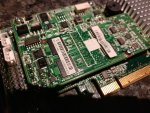Andrew Ostrom
Explorer
- Joined
- Jul 28, 2017
- Messages
- 57
I've wanted to build a FreeNAS system for a while, and it's finally a priority. I've read a lot of articles on building one myself, and I'm confident I could do it, but I wonder if a used commercial server is easier/cheaper/more reliable (I've built plenty of computers over the years, but never a fileserver). I want it to be rack-mount, if possible, to live in the rack in my basement "tech room." It's a room dedicated to my lighting system, network rack, etc., so noise, heat, and power are non-issues (except power cost).
I've found a used Supermicro server on EBay - the link is: https://www.ebay.com/itm/Supermicro...157339?hash=item28709ef49b:g:IjAAAOSwqlxcEUYV
In summary, it's a 4U server, dual Xeon, 64 GB ECC, LSI SAS Controller, etc. It looks like it would make a good FreeNAS box, but I want to be sure before spending that much money. It seems to have plenty of CPU and RAM, the needed SAS2 backplane, and good Ethernet and SAS controllers. I suppose I'll have to flash the LSI controller into IT mode - I did that on the LSI 8207-8i card I have in my PC. Is that still true?
My primary usage is as a file/backup server for 3 to 5 PCs, media server for home theater, etc. I am a serious photographer with several TB of photos, and plan to scan/edit many thousands of 35mm slides and negatives from my pre-digital days. I will be buying a few new disks, but mostly moving several 4TB and 6TB disks from my current PC. I thought that Win10 Storage Spaces would do what I needed, but it was a disaster.
The detailed configuration is:
I've found a used Supermicro server on EBay - the link is: https://www.ebay.com/itm/Supermicro...157339?hash=item28709ef49b:g:IjAAAOSwqlxcEUYV
In summary, it's a 4U server, dual Xeon, 64 GB ECC, LSI SAS Controller, etc. It looks like it would make a good FreeNAS box, but I want to be sure before spending that much money. It seems to have plenty of CPU and RAM, the needed SAS2 backplane, and good Ethernet and SAS controllers. I suppose I'll have to flash the LSI controller into IT mode - I did that on the LSI 8207-8i card I have in my PC. Is that still true?
My primary usage is as a file/backup server for 3 to 5 PCs, media server for home theater, etc. I am a serious photographer with several TB of photos, and plan to scan/edit many thousands of 35mm slides and negatives from my pre-digital days. I will be buying a few new disks, but mostly moving several 4TB and 6TB disks from my current PC. I thought that Win10 Storage Spaces would do what I needed, but it was a disaster.
The detailed configuration is:
- Supermicro SuperChassis 846E1-R1200B Dual 6 Core Xeon 24 x HDD Storage Server
- Dual Intel Xeon E5-2620 15M 2Ghz
- 64GB Ram (8x 8GB PC3-12800R)
- 24x 3.5'' Drive Caddies with Screws Installed
- SAS Controller: LSI 9266-8i
- Ethernet: Intel I350T4BLK (4 Port Gigabit)
- Motherboard X9DRi-F
- Backplane: BPN-SAS2-846EL1
- Power Supplies: Dual PWS-1K21P-1R 1200W 80 Gold Plus



